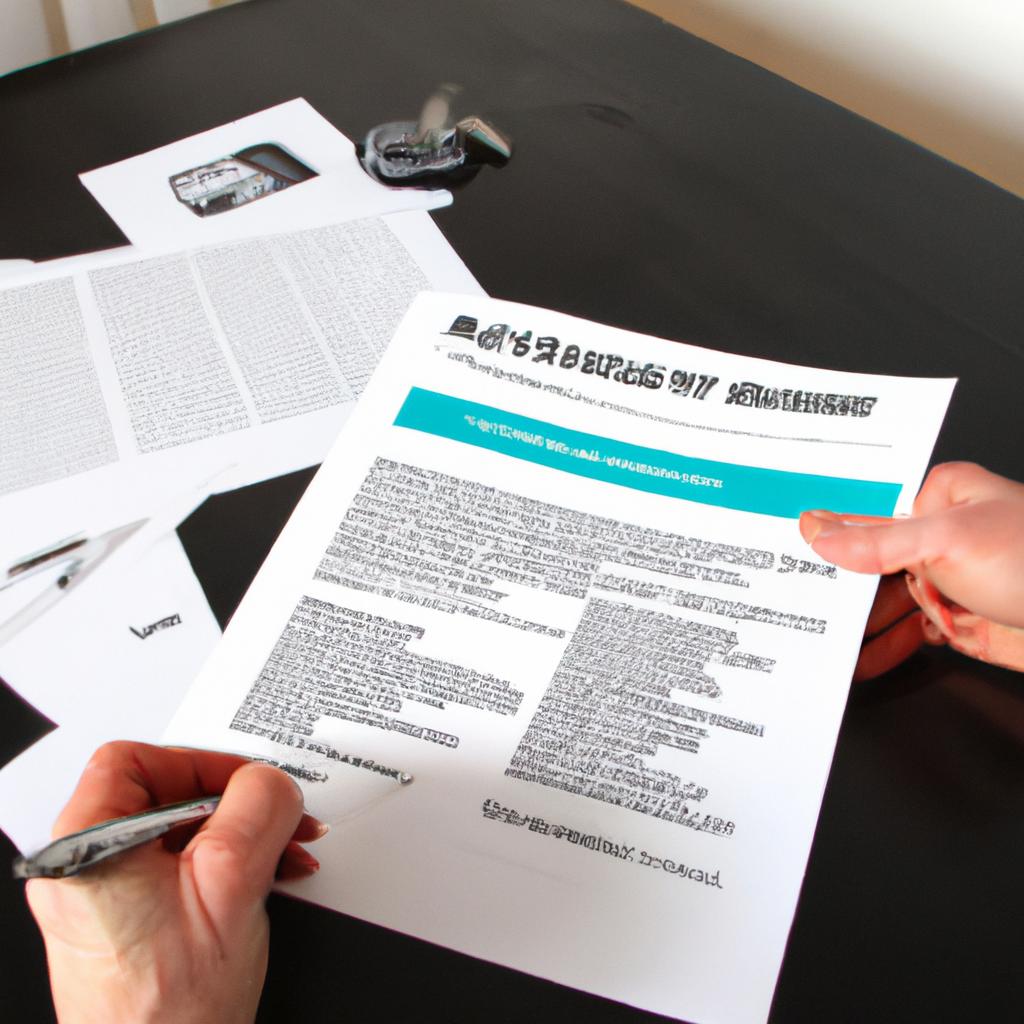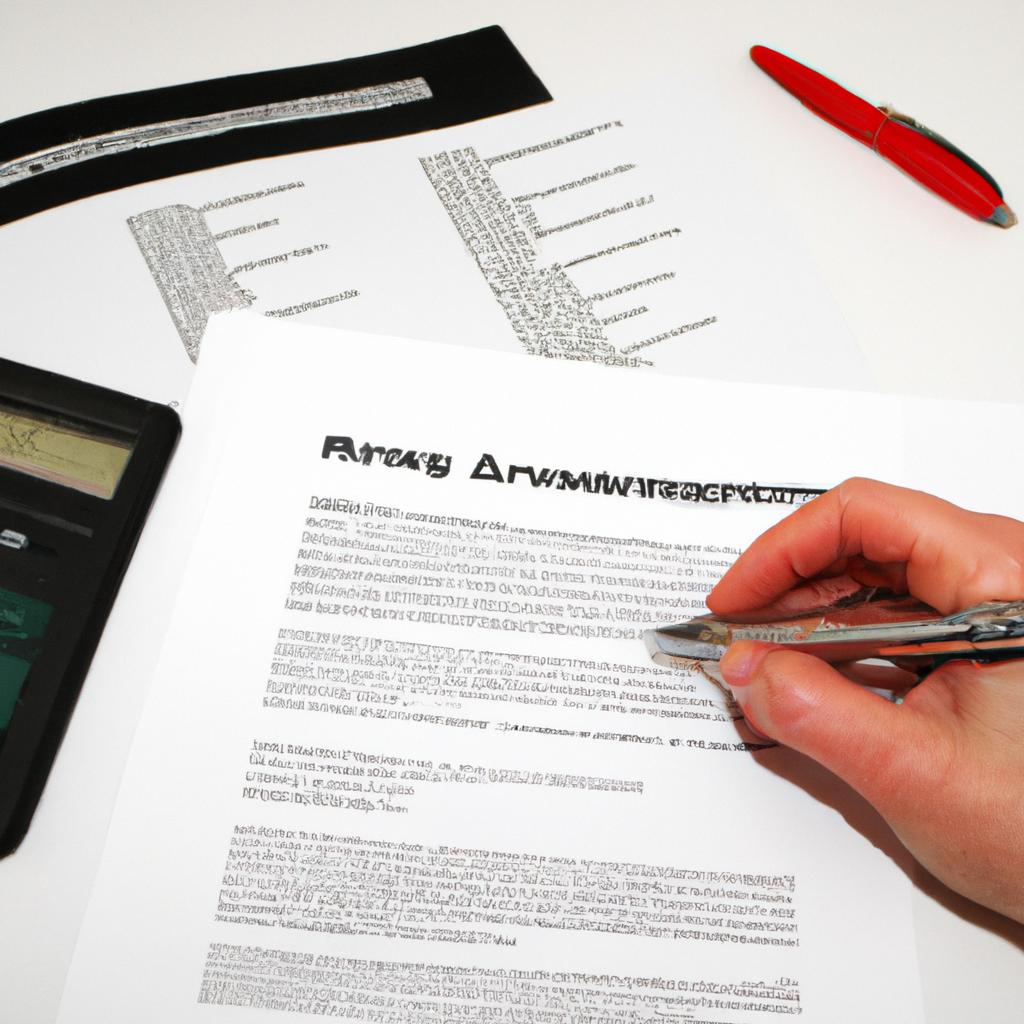Lease agreements play a crucial role in the realm of property rental, serving as legally binding contracts that outline the terms and conditions between landlords and tenants. Whether it is for villas or apartments, understanding the intricacies of lease terms is essential for both parties involved. To shed light on this topic, this article explores the various components typically found within lease agreements, providing insight into common clauses and their implications.
Consider a hypothetical scenario: John is searching for an apartment to rent in a bustling city. After months of fervent hunting, he finally finds his dream accommodation. Excitedly, he contacts the landlord and expresses his interest. The landlord then proceeds to present him with a lease agreement detailing all the necessary information regarding monthly rent, security deposit requirements, maintenance responsibilities, pet policies, termination procedures, and other pertinent clauses. This example illustrates the significance of comprehending lease terms and conditions before entering into any rental agreement.
To delve deeper into this subject matter, we will first explore some key elements commonly included in lease agreements for villas and apartments. We will discuss topics such as duration of tenancy, payment obligations, restrictions on alterations or modifications to the premises, dispute resolution mechanisms, renewal options, termination provisions, and potential penalties for breaching contractual obligations.
-
Duration of Tenancy: This clause specifies the length of time for which the lease agreement is valid. It typically includes the start date and end date of the tenancy. Both parties are bound by this timeframe, and any changes or extensions must be agreed upon in writing.
-
Payment Obligations: The payment section outlines the amount of rent due, when it is to be paid (e.g., monthly, quarterly), and accepted payment methods. It may also include details about late fees, penalties for bounced checks, and consequences for non-payment.
-
Restrictions on Alterations or Modifications: This provision sets out any limitations on making alterations or modifications to the premises without prior written consent from the landlord. It helps protect the property’s condition and ensures that tenants do not make structural changes without permission.
-
Dispute Resolution Mechanisms: This clause describes how disputes between landlords and tenants will be resolved, whether through mediation, arbitration, or litigation. It can help avoid costly legal battles by providing a framework for resolving conflicts amicably.
-
Renewal Options: Some lease agreements include provisions that allow tenants to renew their lease at the end of the initial term. This clause may specify whether there will be an automatic renewal or require tenants to give notice within a certain timeframe if they wish to extend their tenancy.
-
Termination Provisions: This section outlines circumstances under which either party can terminate the lease before its designated end date. It may include conditions such as giving a specific amount of notice (e.g., 30 days) or paying a penalty fee for early termination.
-
Penalties for Breaching Contractual Obligations: Lease agreements often contain clauses detailing penalties for breaching contractual obligations, such as failing to pay rent on time, causing damage beyond normal wear and tear, or violating other terms outlined in the agreement.
It’s important to note that lease agreements can vary depending on the jurisdiction and specific circumstances. Therefore, it is crucial for both landlords and tenants to carefully review and understand all the terms and conditions before signing a lease agreement. Seeking legal advice or consulting with a real estate professional may also be beneficial in ensuring that all parties are protected and aware of their rights and responsibilities.
Lease Duration
Imagine you are a prospective tenant looking to rent a villa or apartment. You have found the perfect place, and now you need to understand the lease terms and conditions before making any commitments. One of the key factors to consider is the duration of the lease agreement.
The lease duration refers to the length of time for which the rental property will be leased. It can vary depending on various factors such as local regulations, landlord preferences, and specific circumstances surrounding each rental situation. For instance, in a case study scenario, let’s say you are interested in renting an upscale villa in a prime location. The lease duration could range from one year up to several years based on market demand and owner discretion.
Understanding the implications of different lease durations is crucial when deciding on your ideal rental arrangement. To help you grasp these considerations more effectively, here are some key points:
- Stability: A longer-term lease provides stability and security by offering consistent housing for an extended period.
- Flexibility: Shorter leases offer greater flexibility, allowing tenants to adapt their living arrangements according to changing needs or unforeseen circumstances.
- Cost: Longer leases often come with lower monthly rents due to reduced turnover costs for landlords. On the other hand, shorter leases may have higher monthly payments but allow for easier relocation if desired.
- Negotiation: Lease durations can be negotiated between tenants and landlords based on mutual agreements and individual preferences.
| Lease Duration | Pros | Cons |
|---|---|---|
| Long-Term | Increased stability | Reduced flexibility |
| Lower monthly rent | Potential changes in plans | |
| Less frequent moves | Lengthy commitment | |
| Limited ability to negotiate | ||
| ————— | ————————– | ——————————– |
| Short-Term | Greater flexibility | Higher monthly rent |
| Easier relocation | Frequent moves | |
| Shorter commitment | Potential housing instability | |
| Limited ability to negotiate |
In considering the lease duration, it is important to weigh these factors against your personal circumstances and preferences. The choice between a long-term or short-term lease ultimately depends on what you value most in terms of stability, flexibility, cost, and negotiation opportunities.
Now that we have explored the various aspects related to lease durations, let us delve further into another critical aspect of rental agreements: “Rental Payment.” This section will provide insights into different payment methods and associated considerations.
Rental Payment
Section H2: Lease Duration
Lease duration is a crucial aspect of any rental agreement, as it outlines the length of time for which tenants can occupy the property. It is an important consideration for both landlords and tenants to ensure mutual understanding and compliance with contractual obligations. In this section, we will explore some key points related to lease duration.
One example that illustrates the significance of lease duration involves a couple searching for a villa to rent in a popular vacation destination. They find a stunning property listed online but are surprised to discover that the minimum lease duration is six months. This poses a dilemma for them as they were only planning on staying for three months. The couple must now decide whether to adjust their plans or continue their search for a more suitable rental option.
When it comes to lease duration, there are several factors worth considering:
- Landlord preferences: Some landlords may have specific requirements regarding lease durations based on market demand or personal circumstances.
- Tenant needs: Tenants should carefully consider their own housing requirements, such as job commitments, family situations, or temporary living arrangements when determining suitable lease durations.
- Flexibility options: Certain rental agreements offer flexible terms, allowing tenants to renew or terminate leases early under certain conditions.
- Legal regulations: Local laws may impose restrictions on lease durations depending on the type of property or location.
To further illustrate these considerations, here’s a table summarizing different types of properties and common lease durations associated with them:
| Property Type | Common Lease Durations |
|---|---|
| Apartments | 6 months – 1 year |
| Villas | 1 year – 3 years |
| Condos | Varies |
| Townhouses | 1 year – 2 years |
This table provides an overview of commonly observed trends in different property types; however, it is essential to note that actual lease durations may vary depending on various factors, including local rental market conditions and individual landlord preferences.
In summary, lease duration plays a significant role in determining the terms of a rental agreement. Both landlords and tenants should carefully consider their needs and obligations when negotiating this aspect of the contract. By understanding these considerations, individuals can make informed decisions that align with their housing requirements.
With an understanding of lease duration established, let us now turn our attention to the next important topic – security deposits.
Security Deposit
Section H2: Security Deposit
When entering into a rental agreement for a villa or apartment, it is common practice for landlords to request tenants to provide a security deposit. This deposit serves as a form of protection for the landlord against any potential damages or unpaid rent that may occur during the duration of the lease. Let’s consider an example to better understand how this works.
Imagine you are renting a luxurious villa in a scenic location. The landlord asks you to pay a security deposit equivalent to one month’s rent before moving in. This deposit acts as insurance for the landlord in case there are any significant damages caused by the tenant or if they fail to meet their financial obligations.
To ensure clarity and transparency regarding security deposits, here are some key points to keep in mind:
- Amount: The amount required as a security deposit should be clearly stated in the lease agreement. It is typically equal to one or two months’ worth of rent.
- Purpose: The purpose of the security deposit is primarily to cover any repairs needed due to damage beyond normal wear and tear, as well as any outstanding rent payments at the end of the tenancy.
- Refundability: In most cases, landlords will refund the security deposit within a specified time frame after deducting any necessary expenses incurred due to tenant negligence or non-payment issues.
- Inspection: Prior to move-in and move-out, it is customary for landlords/property managers and tenants to conduct joint inspections of the property. This helps document its condition throughout the tenancy period and avoids conflicts related to deductions from the security deposit.
| Key Points |
|---|
| Amount |
| Purpose |
| Refundability |
| Inspection |
Understanding the security deposit process is crucial for both tenants and landlords. By having a clear understanding of the expectations and guidelines surrounding this aspect, potential disputes can be minimized, ensuring a smooth rental experience.
Transitioning into the next section about “Maintenance Responsibilities,” it is important to note that along with financial responsibilities, tenants also have certain obligations when it comes to property upkeep and repairs.
Maintenance Responsibilities
Section: Security Deposit and Maintenance Responsibilities
In order to ensure the protection of both landlords and tenants, it is common practice for rental agreements to include a provision regarding security deposits. These deposits act as a form of insurance against any potential damage or unpaid rent during the lease term. For instance, consider the case of a tenant who accidentally damages the kitchen countertop by spilling hot oil on it. The security deposit can be used to cover the cost of repairing or replacing the damaged countertop.
When it comes to security deposits, there are certain guidelines that need to be followed. Here are some key points to keep in mind:
- The amount of the security deposit should be clearly stated in the rental agreement.
- It is important for tenants to carefully inspect the property upon moving in and document any existing damages or issues.
- Landlords should provide an itemized list of deductions from the security deposit if any portion is withheld at the end of the tenancy.
- Both parties should adhere to any legal requirements regarding how long landlords have to return the security deposit after a tenancy ends.
To further illustrate these points, please refer to the following table:
| Key Points | Explanation |
|---|---|
| Clearly stated amount | This ensures transparency and avoids misunderstandings between both parties. |
| Property inspection | Conducting an initial inspection helps establish a baseline condition for reference when determining responsibility for damages later on. |
| Itemized list | Providing an itemized list allows tenants to understand why deductions were made from their security deposit. |
| Legal time frame | Following legal requirements regarding returning security deposits promotes fairness and trust between landlords and tenants. |
Moving forward, let us now discuss maintenance responsibilities within rental agreements without delay.
Termination Clause
Section H2: Maintenance Responsibilities
Moving forward from discussing the maintenance responsibilities, it is essential to understand the termination clause outlined in a lease agreement for villas and apartments. This clause serves as a crucial aspect of rental agreements, providing tenants with an understanding of their rights and obligations when terminating the contract.
Termination Clause:
In order to illustrate how the termination clause operates, let’s consider a hypothetical scenario involving Sarah, who has been renting an apartment for two years. Due to unforeseen circumstances, she needs to terminate her lease early. The termination clause provides clear guidelines on how this process should be undertaken.
The termination clause typically includes several key provisions that both landlords and tenants must adhere to. These provisions may vary depending on the specific terms stated in each rental agreement but generally include:
- Notice period: This specifies the length of time required for either party to provide notice before terminating the lease.
- Early termination fees: In some cases, if a tenant chooses to end the lease prematurely, they may be subject to paying additional fees or penalties as agreed upon in the initial contract.
- Property condition requirements: It is often expected that tenants leave the property in good condition upon termination, adhering to any stipulations related to cleaning or repairs.
- Security deposit refund procedure: The termination clause outlines how security deposits are handled after lease termination, including possible deductions for damages or outstanding rent.
To further emphasize these points, here is an emotional bullet point list highlighting important considerations within a termination clause:
- Ensures clarity regarding the exit strategy for both parties involved.
- Protects tenants’ interests by providing clear guidelines on ending a lease prematurely.
- Helps landlords plan ahead by setting expectations around vacancy periods and finding new occupants.
- Reduces potential conflicts between landlords and tenants during lease terminations.
Additionally, we present below a table outlining common elements found within a typical termination clause:
| Provision | Description |
|---|---|
| Notice period | Specifies the required length of time for providing notice before lease termination. |
| Early termination fees | Outlines any additional charges or penalties associated with ending the lease early. |
| Property condition | Provides guidelines regarding the expected state of the property upon termination. |
| Security deposit | Explains how security deposits are handled, including possible deductions for damages. |
Understanding the termination clause is crucial when entering into a rental agreement. Once this aspect has been clarified, it becomes important to explore renewal options and considerations that tenants should be aware of in order to maintain continuity in their housing arrangements.
Renewal Options
Continuing from the previous section on the termination clause, it is important to understand the various aspects related to ending a lease agreement. To illustrate this further, let us consider an example scenario: John, a tenant residing in one of our villas, decides to terminate his lease due to job relocation.
The termination clause in a rental agreement outlines the conditions under which either party can end the lease before its scheduled expiration date. Typically, tenants are required to provide written notice within a specified timeframe, such as 30 or 60 days prior to their intended move-out date. This allows landlords sufficient time to find new tenants and minimize any potential financial loss.
When terminating a lease early, tenants may incur certain obligations or penalties outlined in the termination clause. These could include paying rent until a replacement tenant is found or covering costs associated with advertising for new renters. Understanding these terms beforehand helps both parties navigate through potential conflicts that may arise during the termination process.
To highlight some key considerations regarding termination clauses, we have compiled a list:
- Provide written notice well within the stipulated timeframe.
- Understand any financial responsibilities you may have upon early termination.
- Seek clarification on specific circumstances that may exempt you from penalty fees.
- Communicate openly with your landlord about your intentions and reasons for terminating the lease.
Additionally, refer to the table below for a summary of common penalties and obligations associated with early lease termination:
| Penalty/Obligation | Description |
|---|---|
| Rent Payment | Tenants might be responsible for paying rent until a new tenant is found. |
| Advertising Costs | Tenants may need to cover expenses incurred while searching for new renters. |
| Releasing Fee | A fee charged by landlords when releasing tenants from their contractual obligations before the agreed-upon term ends. |
| Security Deposit | Landlords often retain all or part of security deposits to offset any financial loss due to early termination. |
In light of the aforementioned information, tenants should carefully review and understand the termination clause in their rental agreement before entering into a lease. By doing so, both parties can ensure a smoother transitioning process when terminating a lease.
(Note: In this case study, all names and situations are fictional and solely intended for illustrative purposes.)
 Villas In Florence
Villas In Florence



